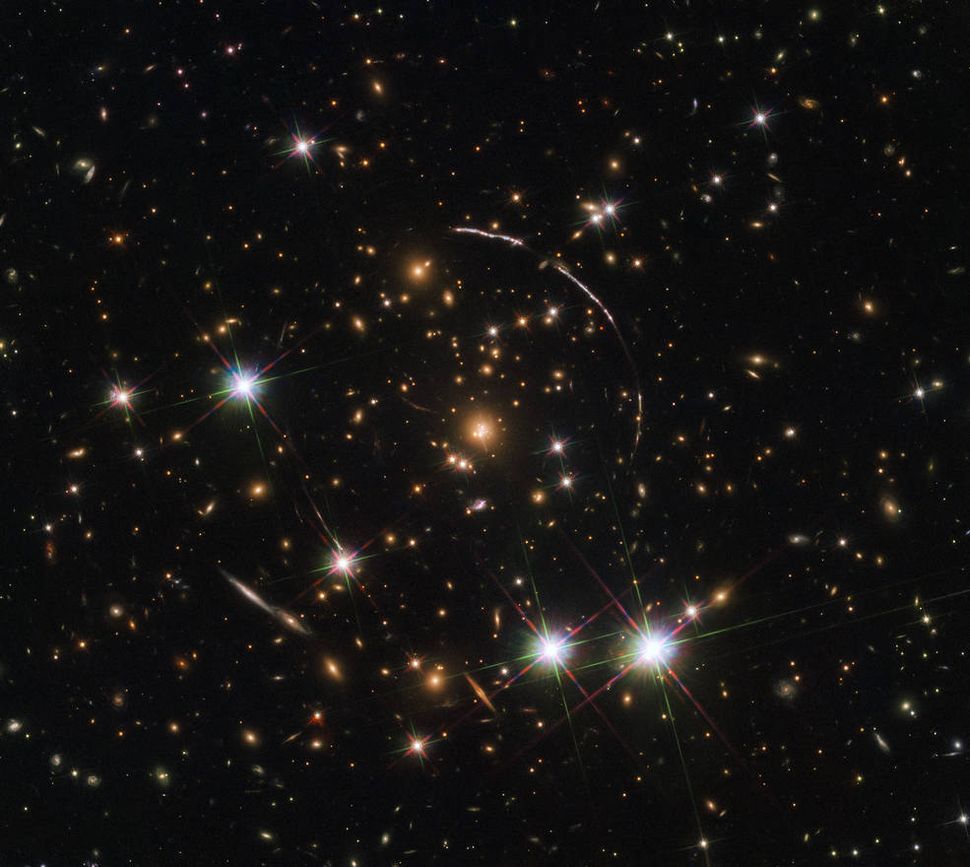Welcome to DU!
The truly grassroots left-of-center political community where regular people, not algorithms, drive the discussions and set the standards.
Join the community:
Create a free account
Support DU (and get rid of ads!):
Become a Star Member
Latest Breaking News
General Discussion
The DU Lounge
All Forums
Issue Forums
Culture Forums
Alliance Forums
Region Forums
Support Forums
Help & Search
Science
Related: About this forumThis Is How Light May Have Escaped from the Earliest Galaxies, Turning the Universe Transparent
By Yasemin Saplakoglu - Staff Writer 8 hours ago

The Hubble Space Telescope recently captured 12 mirror images of the distant, gravitationally-lensed Sunburst Arc. The galaxy can be seen here in this "kaleidoscope" image distributed across four arcs (the elongated lines).
(Image: © NASA, ESA and E. Rivera-Thorsen (Institute of Theoretical Astrophysics Oslo, Norway))
At nearly the beginning of time, the universe was shrouded in darkness. Then, early galaxies produced bright, hot stars that leaked brilliant light intergalactic space through small channels, turning the universe transparent.
That’s the conclusion from gorgeous new "mirror" images taken of a distant galaxy known as the Sunburst Arc. When the universe was just a baby, it was made up of hot, but quickly cooling particles. Once the universe cooled enough, protons and electrons combined to form neutral hydrogen, which covered the universe in darkness, making it unobservable in the electromagnetic spectrum, according to MIT's Haystack Observatory. During this period, known as the dark ages, any radiation emitted was absorbed by the hydrogen gas.
Then, a billion or so years after the Big Bang, during the "Epoch of Reionization," a massive jolt of energy ionized the gas, knocking electrons off the hydrogen atoms and creating plasma. This ionization happened thanks to energetic ultraviolet light that "most likely came from very young, very bright, very hot and also very short-lived stars in the first galaxies," said lead author Thøger Emil Rivera-Thorsen, a postdoctoral fellow at the University of Oslo in Norway. But it's unclear how exactly this ionization event happened.
To figure it out, the researchers turned to a galaxy called the "Sunburst Arc" that sits around 11 billion light-years away (though it's difficult to know exactly how far it is in an expanding universe.) The Sunburst Arc isn't quite old enough to be one of the early galaxies that reionized the universe, but it's old enough to be able to teach the researchers something about the process, Rivera-Thorsen said.
More:
https://www.livescience.com/ionizing-photons-escape-galaxies-small-channels.html
InfoView thread info, including edit history
TrashPut this thread in your Trash Can (My DU » Trash Can)
BookmarkAdd this thread to your Bookmarks (My DU » Bookmarks)
4 replies, 693 views
ShareGet links to this post and/or share on social media
AlertAlert this post for a rule violation
PowersThere are no powers you can use on this post
EditCannot edit other people's posts
ReplyReply to this post
EditCannot edit other people's posts
Rec (8)
ReplyReply to this post
4 replies
 = new reply since forum marked as read
Highlight:
NoneDon't highlight anything
5 newestHighlight 5 most recent replies
= new reply since forum marked as read
Highlight:
NoneDon't highlight anything
5 newestHighlight 5 most recent replies
This Is How Light May Have Escaped from the Earliest Galaxies, Turning the Universe Transparent (Original Post)
Judi Lynn
Nov 2019
OP
JoeOtterbein
(7,700 posts)1. K n R
at140
(6,110 posts)2. Very interesting, but way over my head!
SCantiGOP
(13,869 posts)3. Apparently, at some point,
a bunch of electrons decided Let There Be Light.
2naSalit
(86,601 posts)4. Wow.